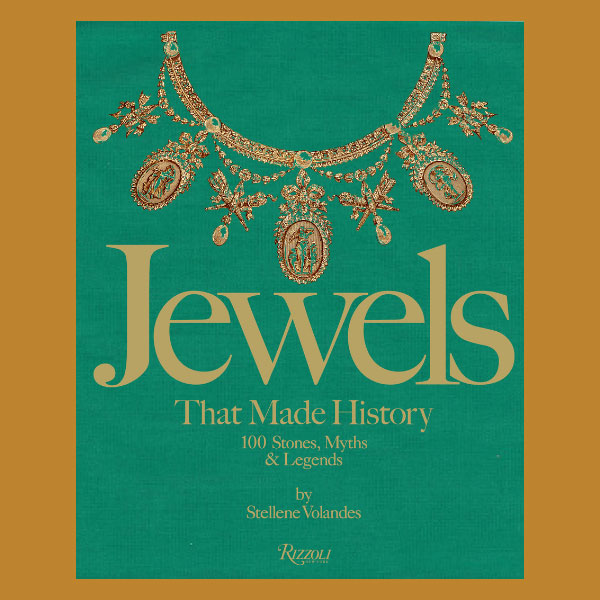
Set your timer and see how long it takes you to breeze through Jewels That Made History: 100 Stones, Myths & Legends (Rizzoli, $45). Published last week, it’s a rapid-fire survey of ancient empires, royal weddings, daring heists, and the enduring allure of the red carpet, all in the context of gems and jewelry design.
Penned by Stellene Volandes, renowned jewelry expert, author, and Town & Country editor-in-chief as well as editorial director of Elle Decor, the narrative is staccato and chipper in tone, the work of a whip-smart storyteller, jewelry sleuth, and dot-connector when it comes to sharing her gems of knowledge. Consuming them, as it were, is as indulgent—and efficient—as plucking hors d’oeuvres from proffered trays at an elegant soiree and calling it dinner.
As Volandes notes in her introduction, “This book is, above all, a call to take jewelry out of the safe, glass vitrine, or velvet box, and place it on the grand stage of history.”
Clearly this is a worthy addition to your personal library, a great gift for staff, or to present in a holiday-themed display (love the emerald green cover) near your store’s point of sale.
But the tidbits/factoids contained within Jewels That Made History are also something retailers can commit to memory and layer into conversations with customers. Educating clients is a big part of the subtle sales pitch—and when you boost your knowledge, you can start discussions that will hopefully lead to purchases.
A few of many examples, below:
1. Anne Boleyn had a gold “B” initial pendant that hung from a strand of pearls. And no one knows what became of it.
2. Napoleon had a thing for cameos that may have stemmed from his conquest of Italy. He wore a cameo-studded crown at his coronation, and the desire for cameo jewelry soon spread across his empire.
3. Queen Victoria was the original influencer.
4. Songwriter Cole Porter introduced Duke Fulco di Verdura to Coco Chanel.
5. When an unsigned piece of a certain era is described as a Mystery Set jewel in an auction catalog, it’s probably Van Cleef & Arpels or something from a bench jeweler who produced for them.
6. To obtain the diamond sunburst brooch Jackie Kennedy wore as a hair ornament to a state dinner in 1962, the first lady traded some diamond jewelry—wedding gifts from her in-laws!—at Wartski London.
7. Chic French singer-songwriter Françoise Hardy was a fan of Van Cleef & Arpels’ Alhambra collection, which debuted in 1968.
8. Princess Diana’s engagement ring was not a custom piece but a ready-to-ship style from Garrard’s catalog that year. As Volandes notes, “It could have been you.”
9. When Lululemon opened its first freestanding store in the year 2000, it was a very good thing for jewelry—diamond jewelry, specifically—because it was the best way to stand out at the gym (or when wearing your yoga gear at the local coffee shop. As one does).
10. Ben Affleck was a “jewelry psychic.”
Top: The cover of Jewels That Made History: 100 Stones, Myths & Legends by Stellene Volandes ©Rizzoli New York, 2020
- Subscribe to the JCK News Daily
- Subscribe to the JCK Special Report
- Follow JCK on Instagram: @jckmagazine
- Follow JCK on X: @jckmagazine
- Follow JCK on Facebook: @jckmagazine